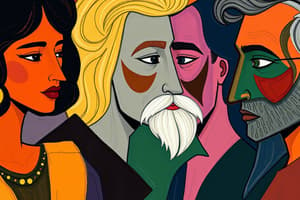Podcast
Questions and Answers
What type of character is the antagonist in a story?
What type of character is the antagonist in a story?
- A hero on a journey
- A force of nature (correct)
- A character who learns from experiences
- A character with numerous traits
Which character best exemplifies a round character?
Which character best exemplifies a round character?
- Boo Radley in To Kill a Mockingbird
- Scout Finch in To Kill a Mockingbird
- Elizabeth Bennet in Pride and Prejudice (correct)
- Voldemort in Harry Potter
Which character is a round character based on the information provided?
Which character is a round character based on the information provided?
- Anne Shirley (correct)
- Jack Dawson
- Gilderoy Lockhart
- Bruce Wayne
What distinguishes the protagonist from the antagonist?
What distinguishes the protagonist from the antagonist?
What distinguishes a dynamic character from a static character?
What distinguishes a dynamic character from a static character?
Which character from the text can be classified as a protagonist?
Which character from the text can be classified as a protagonist?
Which character type is known for exemplifying human growth and development?
Which character type is known for exemplifying human growth and development?
What sets a round character apart from other character types?
What sets a round character apart from other character types?
Study Notes
Character Types: A Closer Look
In the realm of storytelling, characters are the lifeblood of any narrative. Their actions, interactions, and personalities help shape the plot and create a captivating experience for readers or viewers. To better understand how characters contribute to a story, let's delve into the world of character types.
Protagonist
The protagonist is the central character around whom the story revolves. This character often faces challenges, triumphs, and learns from their experiences. The protagonist's journey, known as the hero's or heroine's journey, aims to exemplify human growth and development. Examples of protagonists include Harry Potter, Elizabeth Bennet in "Pride and Prejudice," and Scout Finch in "To Kill a Mockingbird."
Antagonist
The antagonist is the character who presents obstacles for the protagonist and ultimately poses a threat to their goals. The antagonist may be a villain, a rival, or a force of nature. They do not necessarily need to be evil; instead, their motivations might be driven by self-interest, revenge, or misunderstanding. Antagonists include Voldemort, Mr. Collins in "Pride and Prejudice," and Boo Radley in "To Kill a Mockingbird."
Round Character
A round character is a complex individual with numerous traits, motivations, and flaws. Round characters are fully developed and realistic, allowing readers to empathize with them and understand their perspectives. Examples of round characters include Atticus Finch, Anne Shirley in "Anne of Green Gables," and Jay Gatsby in "The Great Gatsby."
Dynamic Character
A dynamic character is a character who undergoes significant change throughout the story. Dynamic characters evolve, grow, or experience a transformation that alters their fundamental beliefs, values, or perspectives. Examples of dynamic characters include Elizabeth Bennet, Scout Finch, and Bruce Wayne in "Batman."
Static Character
In contrast to dynamic characters, static characters do not change significantly or undergo a transformation during the story. Static characters maintain their core traits, flaws, and motivations. Examples of static characters include Hermione Granger, Jack Dawson in "Titanic," and Dorothy Gale in "The Wizard of Oz."
Flat Character
A flat character is a character who has one dominant trait or characteristic. Flat characters are simple, stereotypical, and often serve as plot devices, such as a joke-telling sidekick or a love interest. Examples of flat characters include Tin Man in "The Wizard of Oz," Sir Andrew Agustus Agustus Abbott in "Twelfth Night," and Gilderoy Lockhart in "Harry Potter and the Chamber of Secrets."
In summary, understanding character types is essential for appreciating the diverse and complex characters within literature and other media. These character types help us understand the story's narrative arcs, empathize with characters, and explore human nature through vivid storytelling. As you unravel the pages of a book, watch a movie, or play a video game, keep these character types in mind to deepen your appreciation for storytelling and literature.
Studying That Suits You
Use AI to generate personalized quizzes and flashcards to suit your learning preferences.
Description
Dive into the world of character types in storytelling with a closer look at protagonists, antagonists, round characters, dynamic characters, static characters, and flat characters. Understand how these character types contribute to narrative arcs and enhance the storytelling experience in literature and other media forms.




